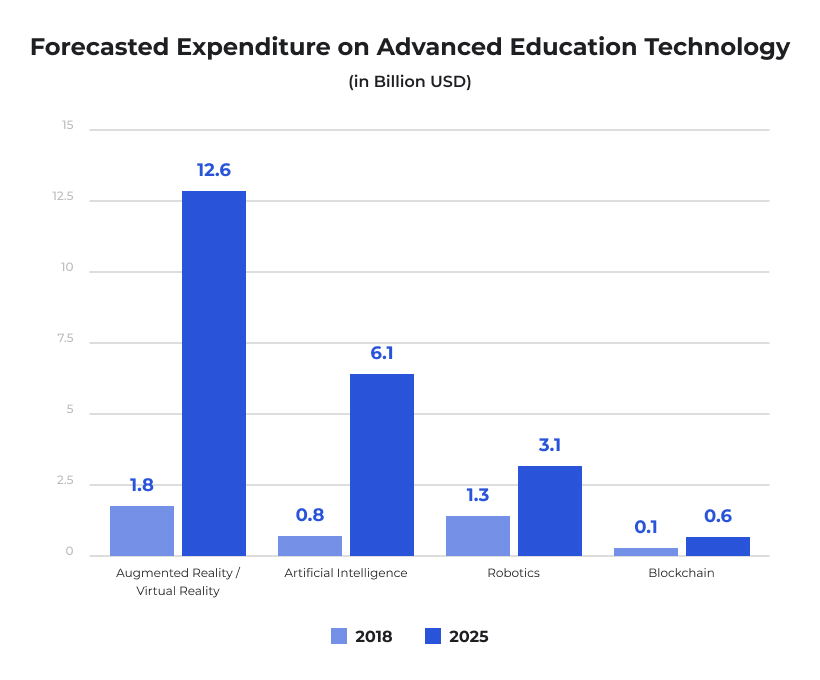Over the past two decades, the concept of new technology in education, commonly referred to as EdTech, has brought about a significant shift in both teaching and studying. The innovative and versatile application of technology in classrooms has not only revolutionized the approach to comprehensive learning but has also enabled educators to deliver personalized learning materials to their students. A key objective of the latest technology in education is to empower students with adaptive learning experiences that cater to their unique intellectual and physical features.
The education sector is currently undergoing a profound transformation driven by the adoption of innovative EdTech solutions. As we’ve entered 2024, several emerging trends in EdTech promise to reshape the educational landscape, offering exciting advancements while also presenting noteworthy considerations for educators and stakeholders alike. More so, the industry’s value is growing at exorbitant rates, valued at around $146 billion in 2023 with a prospective CAGR of 13%.
In today's article, we will take a closer look at how new education technology impacts teachers and students alike and break down the core education technology trends that will shape the industry in 2024 and are here to stay.
Education Technology and Its Importance Explained
Right now, educational technology trends are undergoing a significant evolution, with an increasing number of individuals immersing themselves in the digital realm. As a result, educators need to incorporate tech trends in education into their teaching practices to effectively engage students. Fostering student engagement in learning necessitates innovation and the introduction of fresh ideas to evoke excitement and interest in the subject matter. Given its paramount significance, the integration of new technology in education has become indispensable for educators.

The advancements in technology witnessed over the years have left a noticeable mark on every facet of life. With technology becoming more accessible, its role across various aspects of our daily routines has grown exponentially, thereby elevating our expectations for technological sophistication in all devices we utilize.
Educational institutions have embraced this trend by integrating technology as an integral component of their academic programs. For instance, computer science courses have become a staple offering, empowering students with the skills to code and utilize computers for their academic endeavors.
The utilization of educational technology has become irreplaceable for modern learners, as it enables them to acquire knowledge at an accelerated pace compared to traditional learning methods.
How does educational technology benefit students and teachers?
The continual integration of educational technology tools, encompassing software, hardware, and relevant technological processes, is revolutionizing traditional classroom learning in numerous ways. Educational technology, including robots, facilitates teachers in grading assignments, even as part of homework.
IoT devices enable the creation of virtual classrooms for students, while machine learning and blockchain tools support teachers in managing grading systems and other online learning materials, whether students are physically present in school, traveling, or studying from home.
For students, educational technology proves to be a huge asset providing them with numerous benefits:
- Offering a wide array of online courses and training materials tailored to students' convenience, fostering interactive, engaging, and adaptive learning sessions that enhance interest in online education.
- Automating processes, saving students time spent on travel, note-taking, and similar activities by providing all necessary resources via an app, facilitating rapid understanding of concepts and the way students tackle repetitive tasks.
- Taking a forward-thinking approach by providing collaborative platforms for communication and knowledge-sharing, preparing students for the future.
- Enabling access to diverse information beyond textbooks, exploring video materials, and supplementary study materials, and grasping concepts at their own pace from the web.
For teachers, the emerging technology in education, such as AI-powered automation, creates new exciting opportunities as well:
- Automating assignment checking and grading systems streamlines the process for teachers, enabling them to easily assess students' comprehension of class materials.
- Educational technology simplifies lesson planning for instructors, allowing them to prepare in advance and incorporate fresh, innovative ideas into their teaching.
- With educational technology, accessing student information becomes effortless for teachers, facilitating tailored support and ethical guidance to help students achieve their career goals.
- Since the platform is designed for learners, teachers have full control to manage, track, and extract details, information, courses, study materials, YouTube videos, and other resources based on student learning needs.
Technology Trends that Will Shape 2024 and Beyond
Now that we have discussed the benefits of the technology trends in education, let us take a closer look at the trends that will shape the whole industry in the upcoming years. Some of these trends are emerging technology in education while the others are more or less familiar to tech-savvy users but still influential enough to be included. Let’s get to it!

Automated assessments
Automated assessments take their place among the core educational technology trends as they offer a means to assess students' advancement with growing prevalence. Such tools provide educators and school authorities with enhanced comprehension of students' achievements and pinpoint areas warranting attention.
Automated assessment tools use learning analytics to aid students in recognizing their areas of weakness and addressing them. Additionally, automated grading systems enable swift and precise evaluation of assignments, diminishing the time required for these tasks and freeing up the energy for more creative pursuits.
Cloud computing
Cloud computing remains a crucial asset for educators, enabling streamlined access and storage of data. Moreover, it allows students to economize on costly textbooks by providing easy access to cloud-based materials from any location. Emerging as a prominent trend in educational technology, cloud computing provides robust authentication measures to safeguard data integrity. Additionally, it fosters seamless collaboration among both students and educators.
Wearables technologies
With the increasing prevalence and adaptability of wearable technologies, their influence on learning environments will be substantial. Wearable technology can monitor progress, furnish performance evaluations, and deliver personalized guidance in real time.
On top of that, students can utilize wearable technology such as smartwatches and VR headsets to access audio lectures, receive class updates, take voice notes, and engage in various other activities. This advancement promises to enhance the accessibility and effectiveness of learning, ultimately benefiting educators and parents alike.
AR and VR
Augmented Reality (AR) and Virtual Reality (VR) possess the capability to generate immersive and personalized learning experiences, irrespective of the setting in the future of the education industry and learning in general. They are being integrated as instruments for immersive and hands-on learning. This enables students to delve into virtual realms, undertake practical exercises, and participate in tailored simulations that cater to their specific requirements.
According to this year’s research data by Statista, artificial reality and virtual reality comprise the fastest-growing segment in the new educational technology projected to reach the global value of $12.6 billion by 2025. AI, the second fastest-growing sector, will likely demonstrate just about half of that impressive number.

As both AI and VR in education gain wider acceptance, their influence on the industry will be undeniable. These trends in educational technology revolutionize learning by seamlessly integrating educational content into the real-world environment, offering students enhanced visualization of subjects. They can also transport students to entirely new digital environments. Both approaches captivate learners in new and exciting ways.
Educational facilities can empower teachers with AR and VR tools to:
- Organize virtual field trips
- Elevate language learning through immersive role-playing experiences
- Enable exploration of outer space, ocean depths, or the human body's inner workings
Mobile learning
Following the onset of the Covid-19 pandemic, e-learning platforms have experienced heightened popularity. These platforms allow the students to access top-tier educational materials and instructors from any location globally. Moreover, digital content platforms offer a vast array of learning resources catering to both students and educators. As the prevalence of digital content platforms escalates, the influence on individuals' learning methodologies and interaction with educational materials is poised to expand significantly.
Learning gamification
Gamification involves integrating interactive game-like elements into educational contexts that are typically devoid of such features.
This approach offers numerous advantages for students, including:
Enhancing motivation
Introducing challenges can inspire students to engage more deeply in their learning. For instance, they may feel driven to complete lessons to earn rewards for their virtual character.
Enhancing enjoyment and engagement in learning
Incorporating additional avenues for student interaction with learning materials heightens their enjoyment and level of participation.
Improving retention of knowledge
Gamifying curricula fosters active learning processes and enhances the retention of information.
Cultivating real-world skills
Adapting traditional lessons into game-like formats aids students in developing and applying skills such as problem-solving, teamwork, self-confidence, and fine motor skills.
Facilitating knowledge transfer
Gamifying education enables students to apply their newly acquired skills. For example, they may engage in detective-style activities to gather clues from relevant sources, thereby reinforcing the research skills taught in the curriculum.
The proliferation of new gamification tools in the market continues unabated, indicating no signs of this trend slowing down.
Collaborative learning
The innovative trends in educational technology have facilitated widespread connectivity, offering numerous options for engagement within the field of education. Current trends in Information and Communication Technology have opened up a multitude of routes for collaboration, discussion, and cooperative problem-solving. This collaborative ethos has become increasingly significant in the learning process.
In the traditional classroom setting, educators foster collaboration by assigning group activities and tasks. When students collaborate on projects or work together to tackle challenges, they enhance their collaborative skills. This collaborative effort not only deepens their comprehension but also boosts engagement.

Despite the popularity of eLearning, collaboration remains a key component, with features enabling sharing and discussion among students. Technology has bridged the gap between teachers and students, facilitating more frequent interactions. Teachers are now more accessible, assuming the role of mentors to aid students in their holistic development. This collaborative learning approach promotes peer interaction and cultivates interpersonal skills among students.
AI-powered learning environments
AI-driven technologies like facial recognition, natural language processing, and machine learning are seeing greater adoption in classrooms, enhancing learning experiences by making them more accessible and engaging. AI-enhanced learning environments can deliver a personalized learning experience to students, while also empowering teachers to customize lessons according to each student's unique requirements. Artificial intelligence is quickly becoming integrated into educational tools, and its influence is poised to be significant in the years ahead.
Conclusion
Imagine a world where artificial intelligence comprehends your strengths and areas for improvement, customizes your educational journey, and extends precise assistance at every juncture. Creating technological solutions that benefit learners and educators alike is a complex process, especially when it comes to all the different types of education apps and software solutions that empower collaboration and productivity. With the right technology expertise and industry insight, this world isn't merely a distant vision; it's the present reality for educational facilities worldwide.




